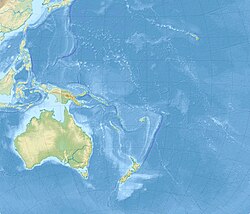| Tupuangi Formation | |
|---|---|
| Stratigraphic range: Cenomanian-Turonian ~ | |
 Tupuangi Formation at Waihere bay, Pitt Island | |
| Type | Geological formation |
| Unit of | Waihere Bay Group |
| Sub-units | Kokowai Allomember, Waihere Allomember, Morgan's Hollow Allomember |
| Underlies | Kahuitara Tuff |
| Overlies | Unseen |
| Thickness | Not bounded, 430 m (1,410 ft) exposed onshore, possibly 700 m (2,300 ft) offshore |
| Lithology | |
| Primary | Sandstone, siltstone |
| Other | Conglomerate |
| Location | |
| Region | Oceania |
| Country | New Zealand |
| Extent | Pitt Island, Chatham Islands |
| Type section | |
| Named for | Tupuangi, Pitt Island |
| Location | Northern end of Waihere Bay |
| Coordinates | 44°15′32.8″S176°14′57.1″W / 44.259111°S 176.249194°W |
| Approximate paleocoordinates | 78°54′S135°54′W / 78.9°S 135.9°W |
| Thickness at type section | ~400 m (1,300 ft) |
The Tupuangi Formation is a geological formation in New Zealand, only exposed on Pitt Island in the Chatham Islands. It is the oldest exposed sedimentary unit within the archipelago. It was deposited in terrestrial deltaic to paralic conditions during the Cenomanian to Turonian ages of the Late Cretaceous. During this time period the Chatham Islands were attached to Antarctica within the Antarctic Circle, at approximately 70° to 80° south.
